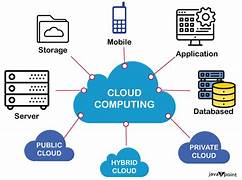How Cloud Computing Has Transformed Data Processing and Storage in Servers
Introduction
Cloud computing has revolutionized the way data is processed, stored, and managed. Before the advent of cloud computing, organizations relied on on-premises servers and traditional data centers, which were costly, complex, and difficult to scale. Today, cloud computing provides flexible, scalable, and cost-effective solutions for businesses and individuals alike. This article explores how cloud computing has changed data processing and storage, its advantages, challenges, and the future of cloud technology.
Understanding Cloud Computing
Cloud computing is a model that delivers computing services—including servers, storage, databases, networking, and software—over the internet. Instead of maintaining physical infrastructure, businesses and users can access these resources on demand from cloud providers such as Amazon Web Services (AWS), Microsoft Azure, Google Cloud, and IBM Cloud.
How Cloud Computing Has Transformed Data Processing
1. Shift from Local to Distributed Processing
Traditionally, data processing was performed on local servers and personal computers. Cloud computing has shifted this workload to distributed computing models, where multiple servers work together in geographically distributed locations to process large amounts of data efficiently.
- Parallel Processing: Cloud platforms distribute computational tasks across multiple servers, increasing efficiency and speed.
- Edge Computing Integration: Data can be processed closer to its source (e.g., IoT devices), reducing latency and bandwidth usage.
- Serverless Computing: Developers can run applications without managing infrastructure, paying only for execution time.
2. Real-Time Data Processing and Analytics
Cloud computing has enabled businesses to process and analyze data in real time, leading to better decision-making and improved customer experiences.
- Streaming Analytics: Services like Apache Kafka and Google Cloud Dataflow allow real-time data processing for financial transactions, social media monitoring, and predictive analytics.
- Artificial Intelligence (AI) and Machine Learning (ML): Cloud-based AI and ML tools analyze massive datasets, enabling businesses to automate processes and improve efficiency.
- Big Data Analytics: Platforms like Hadoop and Spark process large datasets efficiently in the cloud, allowing companies to gain deeper insights into customer behavior, market trends, and operational performance.
3. Scalability and Flexibility
With cloud computing, organizations can scale their data processing needs up or down based on demand. This eliminates the need to invest in expensive hardware for peak loads.
- Auto-Scaling: Cloud platforms automatically allocate computing resources based on workload fluctuations.
- Elastic Computing: Services like AWS EC2 Auto Scaling dynamically adjust resources to optimize performance and cost.
- Multi-Cloud and Hybrid Cloud Solutions: Businesses can use a combination of public and private clouds to balance performance, security, and compliance.
How Cloud Computing Has Transformed Data Storage
1. Shift from Physical to Virtual Storage
In the past, businesses stored data on local hard drives, tape backups, and on-premises data centers. Cloud computing has replaced these methods with virtual storage solutions, offering high availability and accessibility.
- Cloud Object Storage: Services like Amazon S3 and Google Cloud Storage provide unlimited, scalable storage with built-in redundancy.
- Cloud File Storage: Platforms such as Dropbox, OneDrive, and Google Drive enable users to access files from any device.
- Cloud Block Storage: Used for structured data storage, allowing fast retrieval and performance optimization.
2. Improved Data Security and Redundancy
Cloud computing offers robust security measures, protecting data from cyberattacks, natural disasters, and hardware failures.
- Data Replication: Cloud providers store copies of data across multiple locations to ensure high availability and disaster recovery.
- Encryption and Access Control: Cloud services use end-to-end encryption, multi-factor authentication (MFA), and identity management to prevent unauthorized access.
- Backup and Disaster Recovery: Automated backups and recovery solutions reduce downtime in case of data loss.
3. Cost-Effective Storage Solutions
Cloud storage eliminates the need for expensive on-premises infrastructure by offering pay-as-you-go pricing models.
- Cold Storage for Archiving: Solutions like Amazon Glacier provide low-cost, long-term data storage for compliance and record-keeping.
- Tiered Storage Models: Businesses can optimize costs by using high-performance storage for frequently accessed data and lower-cost options for less critical files.
- Reduced IT Maintenance Costs: Cloud providers handle infrastructure maintenance, allowing businesses to focus on innovation.
Advantages of Cloud Computing in Data Processing and Storage
1. Accessibility and Remote Work Enablement
With cloud storage, users can access files from anywhere, enabling remote work, global collaboration, and seamless data sharing.
2. Business Continuity and Disaster Recovery
Cloud computing ensures that businesses can recover data quickly after unexpected failures, minimizing downtime.
3. High Performance and Speed
Cloud services leverage Content Delivery Networks (CDNs), AI-powered optimization, and caching technologies to enhance performance.
4. Environmental Sustainability
Cloud providers use energy-efficient data centers, reducing the carbon footprint of on-premises infrastructure.
Challenges and Considerations
Despite its benefits, cloud computing presents several challenges:
- Security and Compliance Issues:
- Data stored in the cloud is vulnerable to cyberattacks if not properly secured.
- Industries like healthcare, finance, and government must comply with regulations such as GDPR, HIPAA, and CCPA.
- Latency and Connectivity Dependence:
- Cloud services require stable internet connections; slow speeds can impact performance.
- Edge computing solutions help mitigate latency issues by processing data closer to users.
- Vendor Lock-In:
- Migrating between cloud providers can be complex and costly.
- Organizations must adopt multi-cloud strategies to avoid dependency on a single provider.
- Cost Management:
- While cloud storage is cost-effective, uncontrolled usage can lead to unexpected expenses.
- Businesses must monitor storage consumption, data transfer fees, and compute costs.
The Future of Cloud Computing in Data Processing and Storage
As technology evolves, cloud computing is expected to become even more advanced. Some emerging trends include:
- Quantum Computing: Cloud-based quantum computing will enable faster data processing for complex simulations and problem-solving.
- AI and Automation: AI-driven cloud platforms will enhance data analytics, security, and resource optimization.
- Edge Computing Expansion: The integration of 5G networks and edge computing will reduce latency and improve real-time processing.
- Serverless Architecture Growth: More businesses will adopt serverless computing, allowing applications to run without infrastructure management.
Conclusion
Cloud computing has fundamentally changed the way data is processed and stored, offering scalability, cost-efficiency, security, and flexibility. By leveraging cloud-based data processing and storage solutions, businesses can improve efficiency, enable innovation, and enhance security. Despite challenges like security risks and cost management, the future of cloud computing remains promising, with advancements in AI, quantum computing, and edge computing shaping the next era of digital transformation.


